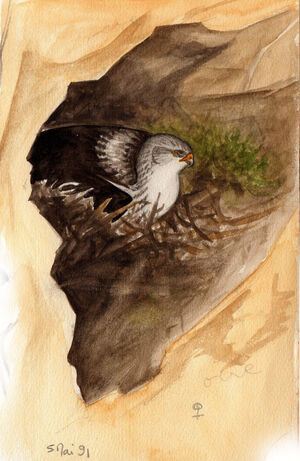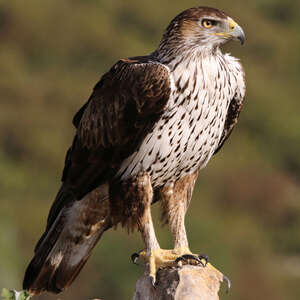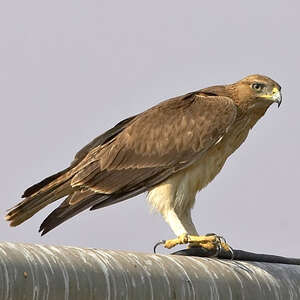Bonelli's Eagle
Aquila fasciata - Aigle de Bonelli
Identification
Bonelli's Eagle is a medium-sized eagle with contrasting plumage and a characteristic silhouette. The length of the tail is equivalent to the width of the wing, or even slightly larger, resembling the Booted Eagle, but in flight, the small head and long tail are more reminiscent of the Eurasian Hobby, which can cause confusion in poor lighting.
The upper parts of an adult are medium brown with darker remiges, but what can be clearly seen in flight is the light patch in the middle of the back.
When viewed from below, the contrast between the wings and body is striking and prevents confusion. In fact, the body is white with more or less visible dark streaks. The coverts, on the other hand, are dark and even black for the larger ones. The remiges are gray, with the primaries slightly paler, but this accentuates the dark underside of the wing. The tail is gray like the hands with a clear black terminal bar.
When perched facing forward, the pale plumage of the body is especially noticeable, including the trousers and tarsus, the iris and the robustness of the beak contrasting with the delicacy of the head.
The juvenile is very different from the adult. When viewed from below, the body and wing coverts are uniformly reddish. The remiges are pale with 6 black fingers at the end of the hand. The tail is also pale and without a black terminal bar. The bird looks more like a Common Buzzard that has no dark spots at the wrist and abdomen.
Subspecific information 2 subspecies
- Aquila fasciata fasciata (n Africa and s Europe to s China and Indochina)
- Aquila fasciata renschi (Lesser Sundas)
Foreign names
- Aigle de Bonelli,
- Águila perdicera,
- águia-perdigueira,
- Habichtsadler,
- héjasas,
- Havikarend,
- Aquila di Bonelli,
- hökörn,
- Haukørn,
- orol jastrabovitý,
- orel jestřábí,
- Høgeørn,
- vuorikotka,
- àguila cuabarrada,
- Haukörn,
- orzeł południowy,
- svītrainais ērglis,
- kragulji orel,
- Ястребиный орёл,
- Elang bonelli,
- ボネリークマタカ,
- 白腹隼雕,
- นกอินทรีแถบปีกดำ,
- 白腹鵰,
Voice song and call
Habitat
In the west of its range, this Bonelli's Eagle can be referred to as a Mediterranean-Montane species.
In the east of its range, it can go much higher in elevation, almost up to 4,000 m altitude, and then it can be sympatric with the Golden Eagle.
Behaviour character trait
Bonelli's Eagle lives a rather solitary life and is quite discreet, hence requiring some attention if one wants to observe it.
However, during the courtship ritual, it displays territorial, gestural and vocal signals that reveal its presence. This is however rather short-lived and comes to a halt once mating season starts.Its hunting takes place in wild and hard-to-access locations, and often escapes our watchful eye. It is a powerful and persistent hunter, able to chase its prey with determination. Nevertheless, its independent nature makes it ill-suited for captivity or falconry, as is the case for the Golden Eagle, for example. Moreover, it is a temperamental bird. It can easily abandon its nest if disturbed in its breeding grounds.
It does not take kindly to the presence of other large raptors in its domain. In spite of the size difference, I have seen it expel a Golden Eagle before.
Flight
Bonelli's Eagle has a more active flight than other raptors of similar size. It practises less gliding flight.
Its beats are supple and light. Together with its particular shape, these could lead to a confusion with the Honey Buzzard.It is during the nuptial parades that it can show all of its flying abilities (vertiginous dives, resources close to the body's resistance limits).
Although it can hunt in ambush, it more prefer to use a low, assured flight while searching for its prey, and to take advantage of the surprise effect as much as possible.
Dietfeeding habits
Bonelli's Eagle is a medium-sized vertebrate predator belonging to the higher classes, reptiles, birds and mammals. Around the Mediterranean, its diet mainly consists of rabbits, red partridges or chukars, pigeons, corvids, but also large lizards like the ocellate or green lizard, all prey that it finds in the nearby area. However, it is capable of longer expeditions if necessary. Thus, for example, birds from the Alpilles or the Lubéron can go as far as the Camargue to hunt seagulls or gulls.
Reproduction nesting
The nest is a large clump of branches in a rocky wall, often in an overhanging ledge. Green elements, such as conifer branches, are deposited there before laying.
Distinguishing it from an eagle's nest is not easy where the two species cohabit. At a date depending on the population in question, the female lays an average of two eggs which she incubates for about 40 days. The juveniles' stay in the nest is around two months. The male's role is to supply the family with food. The emancipation of the young will come later, the later the more abundant the resources are.Geographic range
Bonelli's Eagle is distributed all across the Old World at subtropical latitudes. It can be found from Spain and Morocco to southeastern China, including Asia Minor, the Arabian Peninsula, Iran, India, and northern Indochina. In Africa, only the Maghreb is occupied. A small, isolated population can be found in the Sunda Islands. At these low latitudes, it is strictly sedentary, but the dispersal of emancipated juveniles can carry them hundreds of kilometers away from their native habitat.
Threats - protection
IUCN conservation status
concern
in the Wild
threatened
evaluated
Bonelli's Eagle is not globally threatened. In Europe, however, it is considered "endangered" by the European Community. Its European stronghold is the Iberian Peninsula which accounts for up to 90% of the estimated population of 1,100 - 1,200 pairs and which has recently experienced a significant decline. France is fairly poorly served, with less than 30 pairs and the species' future there is far from assured. Indeed, the threats that weigh on the species are numerous and well-identified: direct destruction, particularly during hunting excursions outside the usual territory, despite official protection, electrocutions on power lines and collisions with electric cables, increasing collisions with wind turbines, a new threat, but also more broadly the alteration of landscapes and the reduction of the number of prey, disturbances from an ever more prevalent outdoor leisure activity, etc. The species should be the subject of specific protection measures, particularly its reproductive territories.
Sources of information
- IOC World Bird List (v15.1), Gill, F and D Donsker (Eds). 2025-12-07.
Other sources of interest
 Specification sheet created on
22/07/2023 by Jean François
Specification sheet created on
22/07/2023 by Jean FrançoisTranslation by AI Oiseaux.net
© 1996-2025 Oiseaux.net
- Accipitriformes
- Aegotheliformes
- Anseriformes
- Apodiformes
- Apterygiformes
- Bucerotiformes
- Caprimulgiformes
- Cariamiformes
- Casuariiformes
- Charadriiformes
- Ciconiiformes
- Coliiformes
- Columbiformes
- Coraciiformes
- Cuculiformes
- Eurypygiformes
- Falconiformes
- Galliformes
- Gaviiformes
- Gruiformes
- Leptosomiformes
- Mesitornithiformes
- Musophagiformes
- Nyctibiiformes
- Opisthocomiformes
- Otidiformes
- Passeriformes
- Pelecaniformes
- Phaethontiformes
- Phoenicopteriformes
- Piciformes
- Podargiformes
- Podicipediformes
- Procellariiformes
- Psittaciformes
- Pterocliformes
- Rheiformes
- Sphenisciformes
- Steatornithiformes
- Strigiformes
- Struthioniformes
- Suliformes
- Tinamiformes
- Trogoniformes





























